Haiping Zhu
LLMSeR: Enhancing Sequential Recommendation via LLM-based Data Augmentation
Mar 16, 2025Abstract:Sequential Recommender Systems (SRS) have become a cornerstone of online platforms, leveraging users' historical interaction data to forecast their next potential engagement. Despite their widespread adoption, SRS often grapple with the long-tail user dilemma, resulting in less effective recommendations for individuals with limited interaction records. The advent of Large Language Models (LLMs), with their profound capability to discern semantic relationships among items, has opened new avenues for enhancing SRS through data augmentation. Nonetheless, current methodologies encounter obstacles, including the absence of collaborative signals and the prevalence of hallucination phenomena.In this work, we present LLMSeR, an innovative framework that utilizes Large Language Models (LLMs) to generate pseudo-prior items, thereby improving the efficacy of Sequential Recommender Systems (SRS). To alleviate the challenge of insufficient collaborative signals, we introduce the Semantic Interaction Augmentor (SIA), a method that integrates both semantic and collaborative information to comprehensively augment user interaction data. Moreover, to weaken the adverse effects of hallucination in SRS, we develop the Adaptive Reliability Validation (ARV), a validation technique designed to assess the reliability of the generated pseudo items. Complementing these advancements, we also devise a Dual-Channel Training strategy, ensuring seamless integration of data augmentation into the SRS training process.Extensive experiments conducted with three widely-used SRS models demonstrate the generalizability and efficacy of LLMSeR.
A Semantic Mention Graph Augmented Model for Document-Level Event Argument Extraction
Mar 12, 2024



Abstract:Document-level Event Argument Extraction (DEAE) aims to identify arguments and their specific roles from an unstructured document. The advanced approaches on DEAE utilize prompt-based methods to guide pre-trained language models (PLMs) in extracting arguments from input documents. They mainly concentrate on establishing relations between triggers and entity mentions within documents, leaving two unresolved problems: a) independent modeling of entity mentions; b) document-prompt isolation. To this end, we propose a semantic mention Graph Augmented Model (GAM) to address these two problems in this paper. Firstly, GAM constructs a semantic mention graph that captures relations within and between documents and prompts, encompassing co-existence, co-reference and co-type relations. Furthermore, we introduce an ensembled graph transformer module to address mentions and their three semantic relations effectively. Later, the graph-augmented encoder-decoder module incorporates the relation-specific graph into the input embedding of PLMs and optimizes the encoder section with topology information, enhancing the relations comprehensively. Extensive experiments on the RAMS and WikiEvents datasets demonstrate the effectiveness of our approach, surpassing baseline methods and achieving a new state-of-the-art performance.
Generalized Category Discovery with Large Language Models in the Loop
Dec 18, 2023
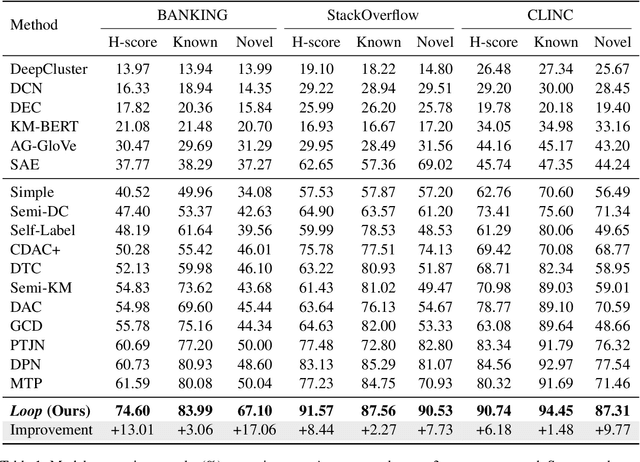

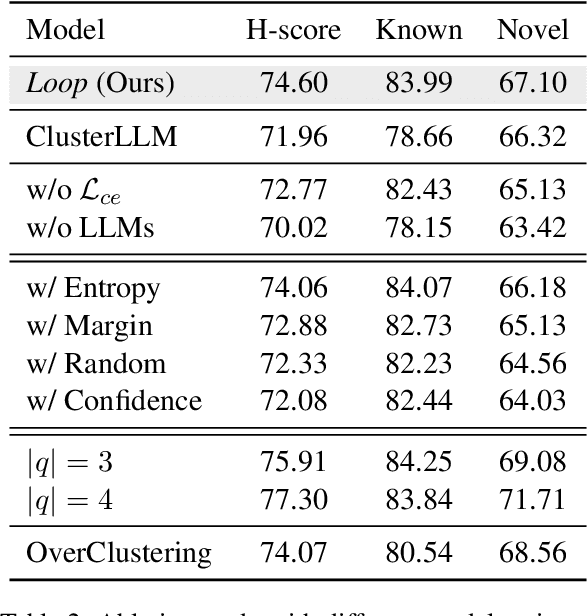
Abstract:Generalized Category Discovery (GCD) is a crucial task that aims to recognize both known and novel categories from a set of unlabeled data by utilizing a few labeled data with only known categories. Due to the lack of supervision and category information, current methods usually perform poorly on novel categories and struggle to reveal semantic meanings of the discovered clusters, which limits their applications in the real world. To mitigate above issues, we propose Loop, an end-to-end active-learning framework that introduces Large Language Models (LLMs) into the training loop, which can boost model performance and generate category names without relying on any human efforts. Specifically, we first propose Local Inconsistent Sampling (LIS) to select samples that have a higher probability of falling to wrong clusters, based on neighborhood prediction consistency and entropy of cluster assignment probabilities. Then we propose a Scalable Query strategy to allow LLMs to choose true neighbors of the selected samples from multiple candidate samples. Based on the feedback from LLMs, we perform Refined Neighborhood Contrastive Learning (RNCL) to pull samples and their neighbors closer to learn clustering-friendly representations. Finally, we select representative samples from clusters corresponding to novel categories to allow LLMs to generate category names for them. Extensive experiments on three benchmark datasets show that Loop outperforms SOTA models by a large margin and generates accurate category names for the discovered clusters. We will release our code and data after publication.
Meta Ordinal Regression Forest for Medical Image Classification with Ordinal Labels
Mar 15, 2022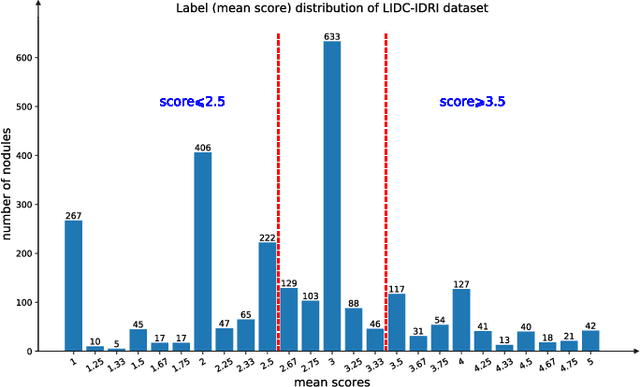
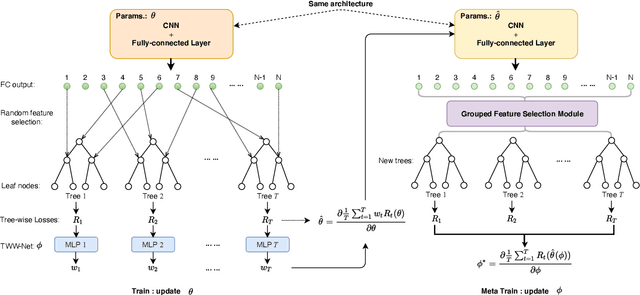
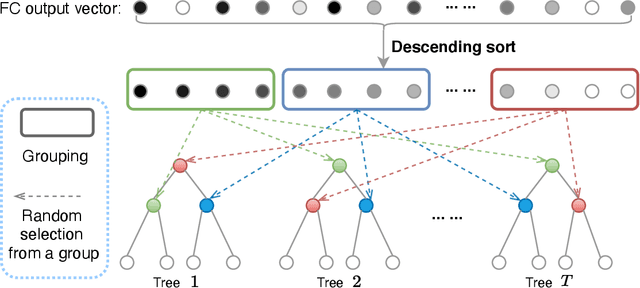
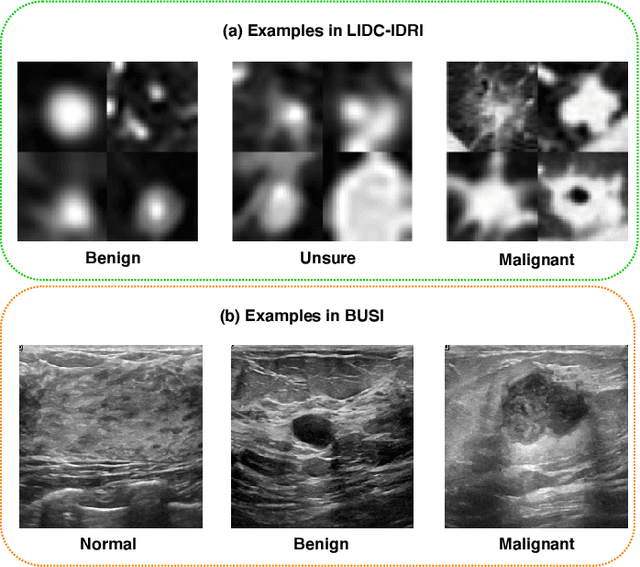
Abstract:The performance of medical image classification has been enhanced by deep convolutional neural networks (CNNs), which are typically trained with cross-entropy (CE) loss. However, when the label presents an intrinsic ordinal property in nature, e.g., the development from benign to malignant tumor, CE loss cannot take into account such ordinal information to allow for better generalization. To improve model generalization with ordinal information, we propose a novel meta ordinal regression forest (MORF) method for medical image classification with ordinal labels, which learns the ordinal relationship through the combination of convolutional neural network and differential forest in a meta-learning framework. The merits of the proposed MORF come from the following two components: a tree-wise weighting net (TWW-Net) and a grouped feature selection (GFS) module. First, the TWW-Net assigns each tree in the forest with a specific weight that is mapped from the classification loss of the corresponding tree. Hence, all the trees possess varying weights, which is helpful for alleviating the tree-wise prediction variance. Second, the GFS module enables a dynamic forest rather than a fixed one that was previously used, allowing for random feature perturbation. During training, we alternatively optimize the parameters of the CNN backbone and TWW-Net in the meta-learning framework through calculating the Hessian matrix. Experimental results on two medical image classification datasets with ordinal labels, i.e., LIDC-IDRI and Breast Ultrasound Dataset, demonstrate the superior performances of our MORF method over existing state-of-the-art methods.
Meta Ordinal Regression Forest For Learning with Unsure Lung Nodules
Dec 07, 2020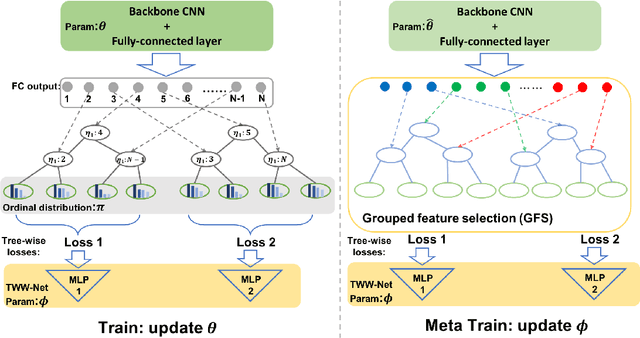

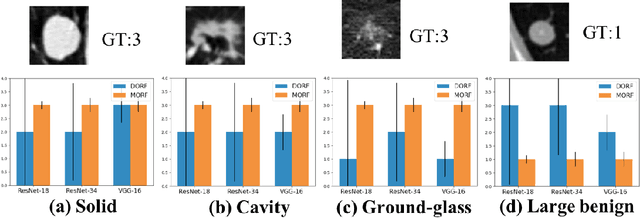
Abstract:Deep learning-based methods have achieved promising performance in early detection and classification of lung nodules, most of which discard unsure nodules and simply deal with a binary classification -- malignant vs benign. Recently, an unsure data model (UDM) was proposed to incorporate those unsure nodules by formulating this problem as an ordinal regression, showing better performance over traditional binary classification. To further explore the ordinal relationship for lung nodule classification, this paper proposes a meta ordinal regression forest (MORF), which improves upon the state-of-the-art ordinal regression method, deep ordinal regression forest (DORF), in three major ways. First, MORF can alleviate the biases of the predictions by making full use of deep features while DORF needs to fix the composition of decision trees before training. Second, MORF has a novel grouped feature selection (GFS) module to re-sample the split nodes of decision trees. Last, combined with GFS, MORF is equipped with a meta learning-based weighting scheme to map the features selected by GFS to tree-wise weights while DORF assigns equal weights for all trees. Experimental results on the LIDC-IDRI dataset demonstrate superior performance over existing methods, including the state-of-the-art DORF.
Deep Ordinal Regression Forests
Aug 07, 2020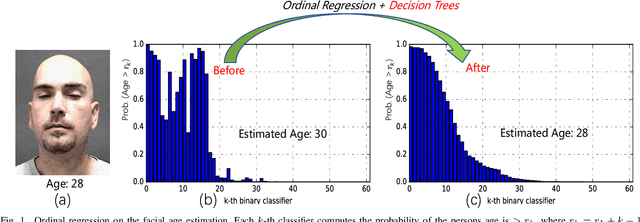
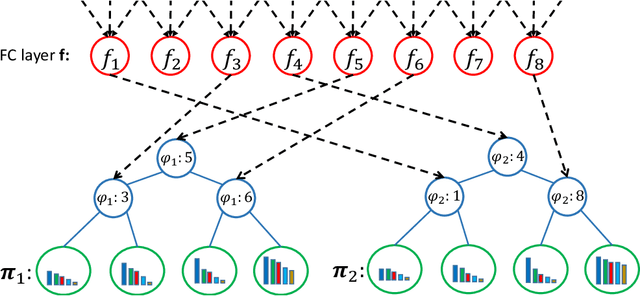

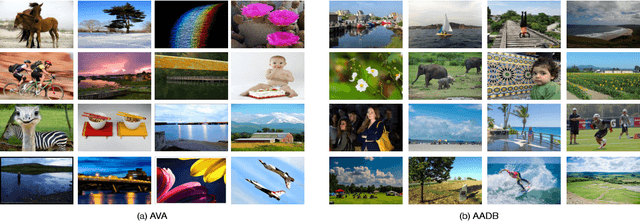
Abstract:Ordinal regression is a type of regression techniques used for predicting an ordinal variable. Recent methods formulate an ordinal regression problem as a series of binary classification problems. Such methods cannot ensure the global ordinal relationship is preserved since the relationships among different binary classifiers are neglected. We propose a novel ordinal regression approach called Deep Ordinal Regression Forests (DORFs), which is constructed with the differentiable decision trees for obtaining precise and stable global ordinal relationships. The advantages of the proposed DORFs are twofold. First, instead of learning a series of binary classifiers independently, the proposed method learns an ordinal distribution for ordinal regression. Second, the differentiable decision trees can be trained together with the ordinal distribution in an end-to-end manner. The effectiveness of the proposed DORFs is verified on two ordinal regression tasks, i.e., facial age estimation and image aesthetic assessment, showing significant improvements and better stability over the state-of-the-art ordinal regression methods.
Look globally, age locally: Face aging with an attention mechanism
Oct 24, 2019


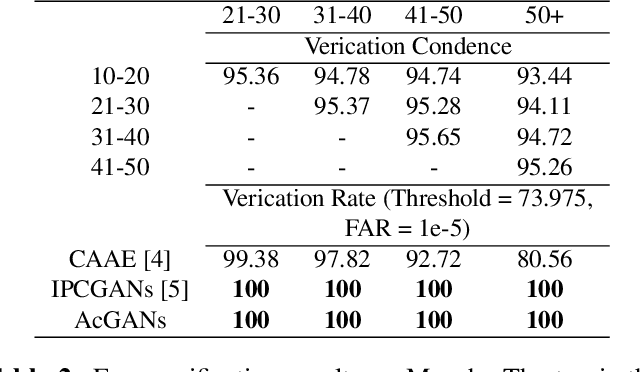
Abstract:Face aging is of great importance for cross-age recognition and entertainment-related applications. Recently, conditional generative adversarial networks (cGANs) have achieved impressive results for face aging. Existing cGANs-based methods usually require a pixel-wise loss to keep the identity and background consistent. However, minimizing the pixel-wise loss between the input and synthesized images likely resulting in a ghosted or blurry face. To address this deficiency, this paper introduces an Attention Conditional GANs (AcGANs) approach for face aging, which utilizes attention mechanism to only alert the regions relevant to face aging. In doing so, the synthesized face can well preserve the background information and personal identity without using the pixel-wise loss, and the ghost artifacts and blurriness can be significantly reduced. Based on the benchmarked dataset Morph, both qualitative and quantitative experiment results demonstrate superior performance over existing algorithms in terms of image quality, personal identity, and age accuracy.
Modeling e-Learners' Cognitive and Metacognitive Strategy in Comparative Question Solving
Jun 04, 2019
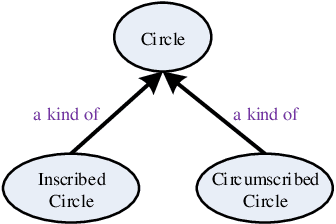
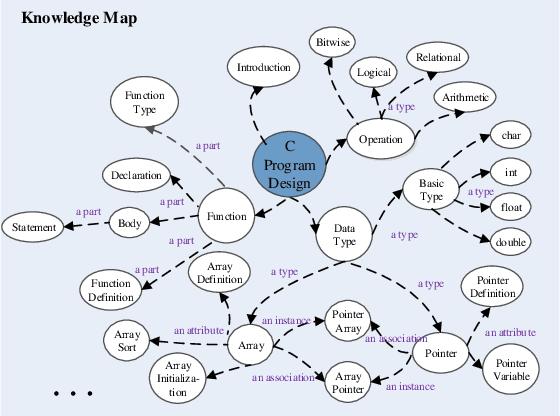
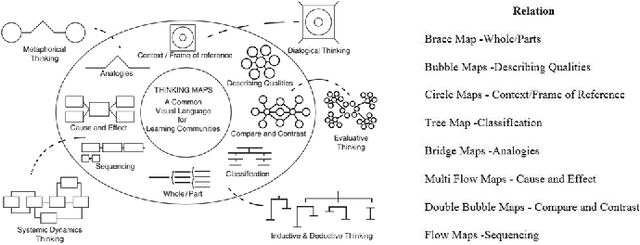
Abstract:Cognitive and metacognitive strategy had demonstrated a significant role in self-regulated learning (SRL), and an appropriate use of strategies is beneficial to effective learning or question-solving tasks during a human-computer interaction process. This paper proposes a novel method combining Knowledge Map (KM) based data mining technique with Thinking Map (TM) to detect learner's cognitive and metacognitive strategy in the question-solving scenario. In particular, a graph-based mining algorithm is designed to facilitate our proposed method, which can automatically map cognitive strategy to metacognitive strategy with raising abstraction level, and make the cognitive and metacognitive process viewable, which acts like a reverse engineering engine to explain how a learner thinks when solving a question. Additionally, we develop an online learning environment system for participants to learn and record their behaviors. To corroborate the effectiveness of our approach and algorithm, we conduct experiments recruiting 173 postgraduate and undergraduate students, and they were asked to complete a question-solving task, such as "What are similarities and differences between array and pointer?" from "The C Programming Language" course and "What are similarities and differences between packet switching and circuit switching?" from "Computer Network Principle" course. The mined strategies patterns results are encouraging and supported well our proposed method.
Ordinal Distribution Regression for Gait-based Age Estimation
May 27, 2019



Abstract:Computer vision researchers prefer to estimate the age from face images due to informative facial features. Estimating the age from face images becomes challenging when people are far away from camcorders or occluded. As the unique biometric feature that can be perceived efficiently at a distance, gait can be an alternative way to predict the age in case that face images are not available. However, existing gait-based classification or regression methods ignore the ordinal relationship of different ages, which is an important clue to the age estimation. In this paper, we proposes an ordinal distribution regression with a global and local convolutional neural network for gait-based age estimation. Specifically, we decompose the gait-based age regression into a series of binary classifications to incorporate the ordinal information of the age. Then an ordinal distribution loss is proposed to take inner relationship among these classifications into account by penalizing the distribution discrepancy between the estimated and the ground-truth. In addition, our neural network consists of a global and three local sub-networks, which is capable of learning the global structure and more local details from head, body and feet of gait, respectively. By comparing with the state-of-the-art methods of gait-based age estimation, this paper highlights, experimentally, that the proposed approach has a better predictive performance on the OULP-Age dataset.
Facial Aging and Rejuvenation by Conditional Multi-Adversarial Autoencoder with Ordinal Regression
Apr 08, 2018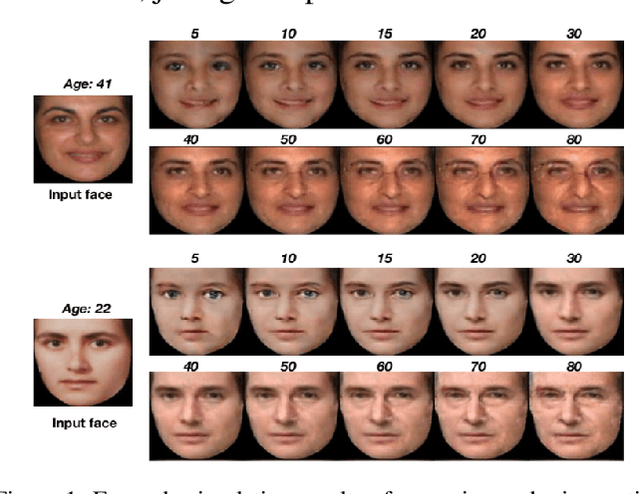

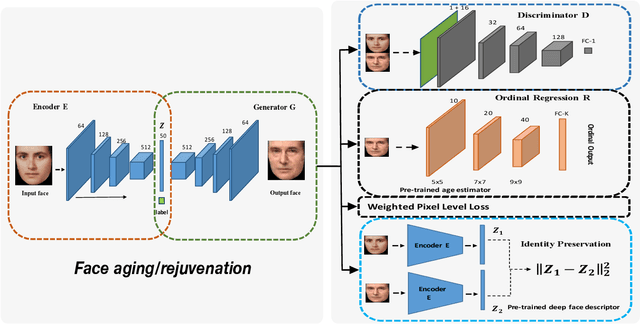

Abstract:Facial aging and facial rejuvenation analyze a given face photograph to predict a future look or estimate a past look of the person. To achieve this, it is critical to preserve human identity and the corresponding aging progression and regression with high accuracy. However, existing methods cannot simultaneously handle these two objectives well. We propose a novel generative adversarial network based approach, named the Conditional Multi-Adversarial AutoEncoder with Ordinal Regression (CMAAE-OR). It utilizes an age estimation technique to control the aging accuracy and takes a high-level feature representation to preserve personalized identity. Specifically, the face is first mapped to a latent vector through a convolutional encoder. The latent vector is then projected onto the face manifold conditional on the age through a deconvolutional generator. The latent vector preserves personalized face features and the age controls facial aging and rejuvenation. A discriminator and an ordinal regression are imposed on the encoder and the generator in tandem, making the generated face images to be more photorealistic while simultaneously exhibiting desirable aging effects. Besides, a high-level feature representation is utilized to preserve personalized identity of the generated face. Experiments on two benchmark datasets demonstrate appealing performance of the proposed method over the state-of-the-art.
 Add to Chrome
Add to Chrome Add to Firefox
Add to Firefox Add to Edge
Add to Edge